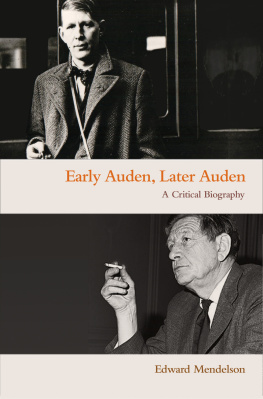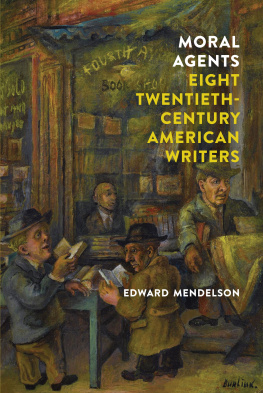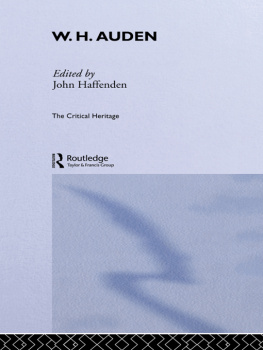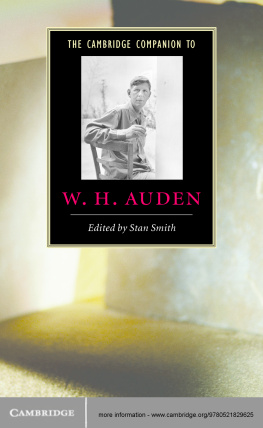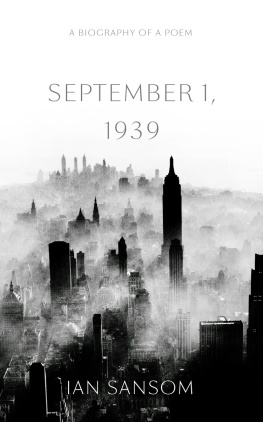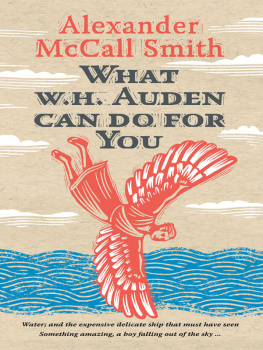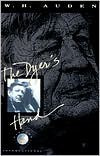
Early Auden, Later Auden
Early Auden, Later Auden
A CRITICAL BIOGRAPHY
Edward Mendelson
PRINCETON UNIVERSITY PRESS
PRINCETON AND OXFORD
Copyright 1981, 1999, 2017 by Edward Mendelson
This book includes the complete text of the work originally published in two volumes as Early Auden (copyright 1981 by Edward Mendelson) and Later Auden (copyright 1999 by Edward Mendelson), revised, expanded, and corrected for this edition.
Postscript: His Secret Life first appeared in different form as The Secret Auden, New York Review of Books, March 20, 2014.
Requests for permission to reproduce material from this work should be sent to Permissions, Princeton University Press
Published by Princeton University Press, 41 William Street, Princeton, New Jersey 08540
In the United Kingdom: Princeton University Press, 6 Oxford Street, Woodstock, Oxfordshire OX20 1TR
press.princeton.edu
Cover images: (Top) Private Collection / Bridgeman Images. (Bottom): Courtesy of dpa Picture Alliance / Alamy Stock Photo
Grateful acknowledgment is made to the following for permission to reprint copyrighted material:
The Estate of W. H. Auden: All previously unpublished writings of W. H. Auden appearing in this volume are used by permission. Copyright 1981, 1999, 2016 by the Executors of the Estate of W. H. Auden.
The Britten Estate: Quotation from Benjamin Brittens diary. Copyright 1981 by the Executors of the Britten Estate.
James Nisbet & Co. Ltd.: Selections from The Changing Face of England by Anthony Collett.
Random House, Inc.: Selections from Selected Poems of W. H. Auden edited by Edward Mendelson. This selection copyright 1979 by Edward Mendelson, William Meredith, and Monroe K. Spears, Executors of the Estate of W. H. Auden.
All Rights Reserved
Library of Congress Cataloging-in-Publication Data
Names: Mendelson, Edward, author.
Title: Early Auden, later Auden : a critical biography / Edward Mendelson ; preface by Edward Mendelson.
Description: Princeton, NJ : Princeton University Press, 2017. | Includes bibliographical references and index.
Identifiers: LCCN 2016034080 | ISBN 9780691172491 (paperback : acid-free paper)
Subjects: LCSH: Auden, W. H. (Wystan Hugh), 19071973Criticism and interpretation. | BISAC: BIOGRAPHY & AUTOBIOGRAPHY / Literary. | LITERARY CRITICISM / Poetry.
Classification: LCC PR6001.U4 Z7584 2017 | DDC 821/.912 [B]dc23 LC record available at https://lccn.loc.gov/2016034080
British Library Cataloging-in-Publication Data is available
This book has been composed in Minion Pro
Printed on acid-free paper.
Printed in the United States of America
1 3 5 7 9 10 8 6 4 2
Early Auden was dedicated to Barry and Valerie Bloomfield
Later Auden was dedicated to Cheryl Mendelson
Contents
Preface to the One-Volume Edition
This book is a history and interpretation of W. H. Audens life and work. It reprints, with revisions, two books published eighteen years apart, Early Auden (1981) and Later Auden (1999). I have appended a postscript, revised from an essay I wrote in 2014 about Audens inner life.
In revising the two books, I have added material that came to light since they appeared and have made minor adjustments and amendments throughout. I have trimmed some repetition between the two books, but I have not tried to reconcile their differences in tone and approach; each is still designed to be read as a self-contained narrative if a reader prefers. Early Auden was a young critics book about a young poet, Later Auden an older critics book about an older poet, and the tone of each still seems suitable to its subject matter. If I were to rewrite the two books today, they would be even more admiring of their subject than they already are.
Auden had mixed feelings about biographical accounts of his life. This book records (in Later Auden, ) the many essays and reviews in which he claimed always to oppose biographies of writers, yet found a reason to make a special exception, he said, in that one essay only, and it notes the many essays in which he wrote detailed accounts of his life, either explicitly or lightly disguised in a way that made the autobiography unmistakableas in his account of a Vision of Agape, which he describes as an excerpt from an unpublished account for the authenticity of which I can vouch, expecting his readers to know that only the person who experienced a vision can attest to having had it. He also took the trouble to write autobiographical records that he knew would be made public at some future time. For a young linguist whom he had befriended, Peter H. Salus, he marked a copy of his first book of poems with the initials of the lovers and friends who were the subject of some of the poems. For an academic critic of his work, Monroe K. Spears, he identified an anonymous contribution he made to an obscure magazine. In each case, he knew perfectly well that academics can be counted on to preserve historical documents for posterity.
Auden divided his 1966 Collected Shorter Poems into four sections, each representing what he described in his foreword as a chapter in my life. His first two sections, dated 192732 and 193338, correspond to the two parts of Early Auden. The last two sections, dated 193947, when he was living in the United States all year round, and 194857, when he summered in Italy, correspond to the first two parts of Later Auden; the third part covers the work of his last years, when he summered in Austria. In the opening chapters of each of these five parts I try to characterize Audens ideas and methods during the entire period, and the remaining chapters treat separate issues in greater detail and in roughly chronological sequence.
The most rapid and drastic changes in Audens life occurred during a period of about a dozen years starting around 1936. Early Auden devotes almost as much space to 193638 as to the nine preceding years; Later Auden devotes as much space to 193947 as to the next quarter century. But in both books, I have tried to show that the poems Auden wrote before and after this period of psychological and historical crises were as memorable as those he wrote during it, and that much of his most profound and personal work was written in the last fifteen years of his life.
When I refer to Audens first or earliest poems, I mean the first poems he wanted to preserve, those he began writing in the late summer of 1927, when he was twenty years old. For the purposes of this book, his juvenilia call for no more than a few paragraphs, which they receive in Early Auden, .
The most illuminating material added to this new edition derives from a journal that Auden kept from the end of August to late November 1939. Auden mentioned it at the time in letters to friends, but it then seemed to have been lost or destroyed. It came to light a few years ago, following the sudden death of the musicologist who, in the 1970s, had purloined it from its proper owner and, for the rest of his life, kept its existence secret from his family and everyone else. (The journal was among the manuscripts that Auden gave to his friend George Davis, who had rented the house in Brooklyn where he, Auden, and others lived and worked in the early 1940s.) The full account of the journals disappearance and recovery is, as Holmes said to Watson about the giant rat of Sumatra, a story for which the world is not yet prepared.

Auden frequently revised his poems and dropped increasing numbers of them from his retrospective selected and collected editions.
Next page
